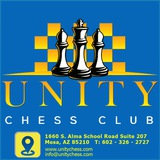Slightly less accurate is 29.e4, since this move limits the manoeuvrability of his own knight.
29...Be6 30.Rb1 Rc7 31.Rb7 Rxb7 32.Nxb7 Kd7 33.Nd6 h6 34.Kf2 Kc6 35.Ke3 a5 36.Ne8 f5 37.Ng7 Bd7 38.gxf5 gxf5 39.f4 Kd5 40.c6 Bc8 41.c7 Kd6 42.h4
Unity Chess Club
Boris Spassky Sergei Avtonomov Leningrad 1949 White to move
Black’s pieces are harmoniously placed, but he has forgotten to develop his kingside, and his king has not castled. If one could just ‘correct’ the position by putting the bishop on e7, Black would have no problems, but it is White to move.
A blow on the most strongly-defended square in Black’s camp, which he is covering with five pieces, wins the game for White.
At the cost of a pawn, White opens lines, exploiting his advantage in development.
At the cost of a pawn, White opens lines, exploiting his advantage in development.
After 17...Qd7 18.Re1 Kf8 19.Qh5, the knight comes to f5 with decisive effect.
Unity Chess Club
Efim Geller Robert Fischer Curacao 1962 White to move
In such structures, a great role is played by the pawn on a5, which holds back two black pawns, and stops him playing the strengthening move ...b7-b6. And with the c5-pawn unsupported, White played...
In whatever form the pawns on b4 and c5 are exchanged for each other (and ‘exchanged’ is the operative word, because if Black captures on b4, his pawn will not survive there long), Black is guaranteed a backward pawn on the b-file. On the other hand, White’s pawn pair will represent a real threat, because if the b7-pawn falls, they will be connected passed pawns. It is important too that the Bg6 is just a spectator to what is going on. A knight on d7 would be a much more useful piece, taking part in the blockade of the white pawns.
17...Rac8 18.Qb3 Bd6 19.Rfd1 Qe7 20.bxc5 Bxc5 21.Bxc5 Rxc5 22.Ra1 Rd8 23.Ra4!
23...Bf5 24.Rb4 Bc8 25.Rb6 Rd6 26.Qb4 Qc7 27.Rxd6 Qxd6 28.Rb1 Qc7 29.Qa4! Bd7 30.Qa3 Rxa5 31.Rxb7 Qxb7 32.Qxa5 g6 33.h3!
The connected pawns are impossible to block, so White is in no hurry, and makes a useful prophylactic move first.
33...Qb1+ 34.Kh2 Bf5 35.Qc3! Qe4 36.Bf3 Qd4 37.Qxd4 exd4 38.g4 Bc8 39.c5 a5 40.c6 Kf8 41.d6 1-0
